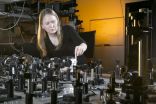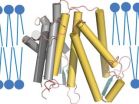(Press-News.org) DURHAM, N.C. -- Duke University researchers have made fluorescent molecules emit photons of light 1,000 times faster than normal -- setting a speed record and making an important step toward realizing superfast light emitting diodes (LEDs) and quantum cryptography.
This year's Nobel Prize in physics was awarded for the discovery of how to make blue LEDs, allowing everything from more efficient light bulbs to video screens. While the discovery has had an enormous impact on lighting and displays, the slow speed with which LEDs can be turned on and off has limited their use as a light source in light-based telecommunications.
In an LED, atoms can be forced to emit roughly 10 million photons in the blink of an eye. Modern telecommunications systems, however, operate nearly a thousand times faster. To make future light-based communications using LEDs practical, researchers must get photon-emitting materials up to speed.
In a new study, engineers from Duke increased the photon emission rate of fluorescent molecules to record levels by sandwiching them between metal nanocubes and a gold film.
The results appear online October 12 in Nature Photonics.
"One of the applications we're targeting with this research is ultrafast LEDs," said Maiken Mikkelsen, an assistant professor of electrical and computer engineering and physics at Duke. "While future devices might not use this exact approach, the underlying physics will be crucial."
Mikkelsen specializes in plasmonics, which studies the interaction between electromagnetic fields and free electrons in metal. In the experiment, her group manufactured 75-nanometer silver nanocubes and trapped light between them, greatly increasing the light's intensity.
When fluorescent molecules are placed near intensified light, the molecules emit photons at a faster rate through an effect called Purcell enhancement. The researchers found they could achieve a significant speed improvement by placing fluorescent molecules in a gap between the nanocubes and a thin film of gold.
To attain the greatest effect, Mikkelsen's team needed to tune the gap's resonant frequency to match the color of light that the molecules respond to. With the help of co-author David R. Smith, the James B. Duke Professor and Chair of Electrical and Computer Engineering at Duke, they used computer simulations to determine the exact size of the gap needed between the nanocubes and gold film to optimize the setup.
That gap turned out to be just 20 atoms wide. But that wasn't a problem for the researchers.
"We can select cubes with just the right size and make the gaps literally with nanometer precision," said Gleb Akselrod, a postdoc in Mikkelsen's lab and first author on the study. "When we have the cube size and gap perfectly calibrated to the molecule, that's when we see the record 1,000-fold increase in fluorescence speed."
Because the experiment used many randomly aligned molecules, the researchers believe they can do even better. They plan to design a system with individual fluorescent molecule placed precisely underneath a single nanocube. According to Akselrod, they can achieve even higher fluorescence rates by standing the molecules up on edge at the corners of the cube.
"If we can precisely place molecules like this, it could be used in many more applications than just fast LEDs," said Akselrod. "We could also make fast sources of single photons that could be used for quantum cryptography. This technology would allow secure communication that could not be hacked -- at least not without breaking the laws of physics."
INFORMATION:
This work was supported by the Lord Foundation of North Carolina and the Air Force Office of Scientific Research (Contract No. FA9550-12-1-0491).
Gleb M. Akselrod, Christos Argyropoulos, Thang B. Hoang, Cristian Ciracì, Chao Fang, Jiani Huang, David R. Smith, Maiken H. Mikkelsen. "Probing the mechanisms of large Purcell enhancement in plasmonic nanoantennas." Nature Photonics, 2014. DOI:10.1038/nphoton.2014.228
From joint replacements to cardiac implants and dialysis machines, medical devices enhance or save lives on a daily basis. However, any device implanted in the body or in contact with flowing blood faces two critical challenges that can threaten the life of the patient the device is meant to help: blood clotting and bacterial infection.
A team of Harvard scientists and engineers may have a solution. They developed a new surface coating for medical devices using materials already approved by the Food and Drug Administration (FDA). The coating repelled blood from more ...
In spite of its dangerous reputation, cholesterol is in fact an essential component of human cells. Manufactured by the cells themselves, it serves to stiffen the cell's membrane, helping to shape the cell and protect it. By mapping the structure of a key enzyme involved in cholesterol production, Rockefeller University researchers and a colleague in Italy have gained new insight into this complex molecular process.
"This is the first report to pinpoint the location of every atom — in this case nearly 3,000 of them — in one of the membrane-embedded enzymes ...
CAMBRIDGE, Mass--A surprising phenomenon has been found in metal nanoparticles: They appear, from the outside, to be liquid droplets, wobbling and readily changing shape, while their interiors retain a perfectly stable crystal configuration.
The research team behind the finding, led by MIT professor Ju Li, says the work could have important implications for the design of components in nanotechnology, such as metal contacts for molecular electronic circuits.
The results, published in the journal Nature Materials, come from a combination of laboratory analysis and computer ...
Two research teams working in the same laboratories at UNSW Australia have found distinct solutions to a critical challenge that has held back the realisation of super powerful quantum computers.
The teams created two types of quantum bits, or "qubits" – the building blocks for quantum computers – that each process quantum data with an accuracy above 99%. The two findings have been published simultaneously today in the journal Nature Nanotechnology.
"For quantum computing to become a reality we need to operate the bits with very low error rates," says Scientia ...
Concerns over human-insecticide exposure has stimulated the development of alternative bed bug control materials, and many essential oil-based pesticides and detergent insecticides have been developed in recent years. But how well do they work? To find out, researchers from Rutgers University evaluated the efficacy of nine essential oil-based products and two detergents that are labeled and marketed for bed bug control. The results are published in an article in the Journal of Economic Entomology.
The non-synthetic bed bug pesticides — which contain ingredients ...
A noninvasive method of delivering a promising therapy for persistent Clostridium difficile (C. difficile) infection appears to be as effective as treatment via colonoscopy or through a nasogastric tube. In their JAMA report, receiving early online release to coincide with a presentation at the Infectious Diseases Society of America's ID Week conference, investigators from Massachusetts General Hospital (MGH) report that oral administration of the therapy called fecal microbiota transplant (FMT) in acid-resistant capsules was as successful as more invasive methods in eliminating ...
A preliminary study has shown the potential of treating recurrent Clostridium difficile infection (a bacterium that is one of the most common causes of infection of the colon) with oral administration of frozen encapsulated fecal material from unrelated donors, which resulted in an overall rate of resolution of diarrhea of 90 percent, according to a study published in JAMA. The study is being released early online to coincide with its presentation at IDWeek 2014.
Recurrent Clostridium difficile infection (CDI) is a major cause of illness and death, with a recent increase ...
DETROIT – Patients who have plastic surgery to reshape their bodies after bariatric procedures are able to maintain "significantly greater" weight loss than those who do not have surgery, according to a new study by Henry Ford Hospital researchers.
"As plastic and reconstructive surgeons, we are encouraged by the idea that improved body image can translate into better long-term maintenance of a healthier weight, and possibly a better quality of life for our patients," says Donna Tepper, M.D., a Henry Ford plastic surgeon and senior author of the study.
Study results ...
SAN DIEGO, CA, October 11, 2014 – Cough is among the most common complaints for which patients seek medical attention. Leading cough researcher Peter V. Dicpinigaitis, M.D., Professor of Clinical Medicine at New York's Albert Einstein College of Medicine, recently conducted a new cough challenge study among adults, whose results were first presented at the European Respiratory Society International Congress in September 2014. The study was conducted using 22 adults with acute URI (common cold) who underwent cough reflex sensitivity measurement employing capsaicin ...
A major complication associated with diabetes is delayed cell replication in epithelium and skin. Researchers at The Pennsylvania State University College of Medicine, Hershey, Pennsylvania have reported the presence and function of the opioid growth factor (OGF) and its nuclear-associated receptor (OGFr) in skin. OGF, an inhibitory growth factor, chemically termed [Met5]-enkephalin, can be upregulated in diabetes leading to depressed cell proliferation. Topical naltrexone, a general opioid antagonist, stimulates cell replication but the specific ligand - opioid receptor ...



